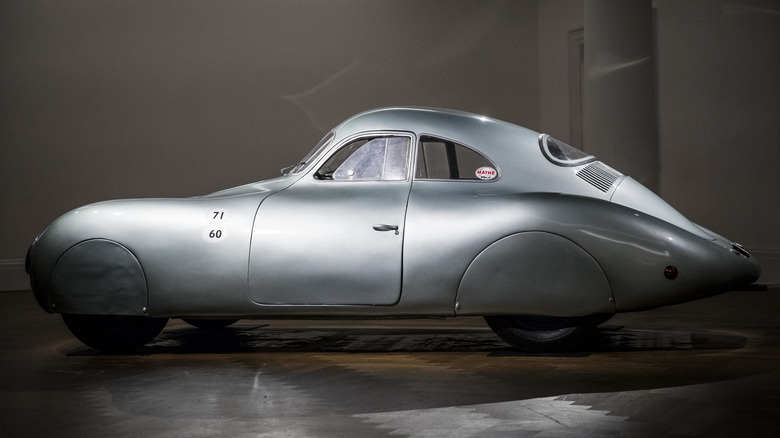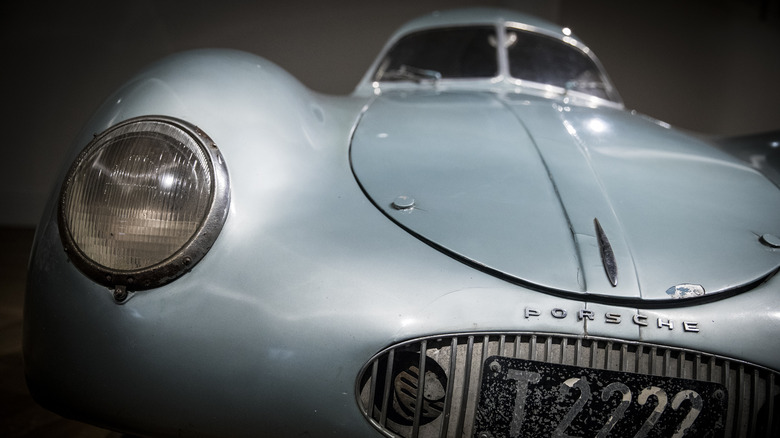One Of The First Porsches Was Destroyed By American Troops In WW2
For many, the legendary "Porsche" name epitomizes nothing but the best of German sportscar engineering. But all legends must start somewhere, and the Type 64 — aka the "first Porsche" — is where this now-famous name brand begins. And ironically, the "first Porsche" wasn't even a "Porsche."
Long before the iconic brand was even created in 1948, Dr. Ferdinand Porsche worked at a number of car manufacturers, including Austro-Daimler, Mercedes-Benz, and Volkswagen (as a consulting engineer). While it's an undeniable fact that Porsche was an innovative engineering genius, he was also a member of the Nazi Party who built cars for Hitler that aided in Nazi propaganda. On May 22, 1939, Germany's Adolf Hitler and Italy's Benito Mussolini entered into the "Pact of Steel" alliance between their respective countries. To celebrate that alliance, Hitler wanted to hold an automobile race from Berlin to Rome spanning some 932 miles (1,500 km).
As noted by Sotheby's, Volkswagen had already built German military vehicles for Hitler, including the Kübelwagen and Schwimmwagen, and when the National Socialist Motor Corps (NSKK) came with a new commission for a race car, they assigned Porsche to the task. In a twist of automotive fate, Porsche had proposed a sports car version of the Beetle, known as the KdF-Wagen, just a year before. This was dubbed "Type 114" and was ultimately rejected, but the design would get resurrected with the creation of Type 64.
Made for Hitler's Berlin to Rome race
The Type 64 had a 985 cc, 1.1-liter flat-four VW engine that kicked out anywhere between 32 horsepower and 50 horsepower (depending on which historical record you read). According to " The Drive, " it topped out at about 99 miles per hour. Porsche wanted it as light and aerodynamic as feasible, so the body was made from the lightest aluminum available and included shrouds across the wheel wells. Sotheby's detailed history of the Type 64 listed the curb weight at a mere 1,346 pounds and had characteristics that resembled an aircraft more than any Beetle.
Only three of these prototypes were ever built, and only one survives today. None made it into Hitler's Berlin to Rome race because World War II erupted, and the race was canceled. According to Sotheby's, Dr. Bodo Lafferentz — head of the German Labour Front — took possession of the first car. It was reportedly damaged in an accident in 1939, but not beyond repair.
Around this time, Ferdinand Porsche's son Ferry urged Volkswagen to build two additional cars for "testing and experimentation purposes." The second car was built shortly after his recommendation, and the body for the third was reportedly completed in 1940. Still, it wasn't mounted to a chassis until after the crash involving Dr. Lafferentz's original model. According to Sotheby's, Lafferentz's Type 64 made its way back to Porsche's facility, where the third body was used to repair his vehicle and is the only original to survive.
The Rainbow Division takes the Porsche for a ride
But what about that second car? Well, towards the end of World War II, that second Type 64 somehow ended up in the hands of the 42nd Infantry's "Rainbow Division," who summarily cut the roof off and quite literally drove it until the engine blew up. The Army left it for scrap, which someone miraculously recovered at some point because according to The Value, that scrap was used to make a re-creation in 2011.
But the story of the Type 64 goes on. The only original not in the hands of the Porsche family went up for auction on August 18, 2019, at the Portola Hotel and Spa in Monterey, California. According to Motor Trend it was expected to sell somewhere around $20 million, making it the most valuable Porsche ever sold at auction. But... it never sold. Not because it wasn't wanted, but because there was confusion as to the actual starting and bid prices. Apparently, it was difficult to understand the auctioneer, and the person operating the bidding information screens repeatedly listed the wrong values thinking they heard different monetary amounts. When the first bid was $13 million, the screens showed a bid for $30 million, then a bid for $14 million was shown as $40 million, and so forth on up to $70 million. The auctioneer finally realized the error and shortly thereafter declared the car unsold.

